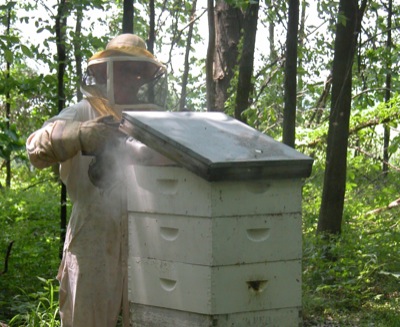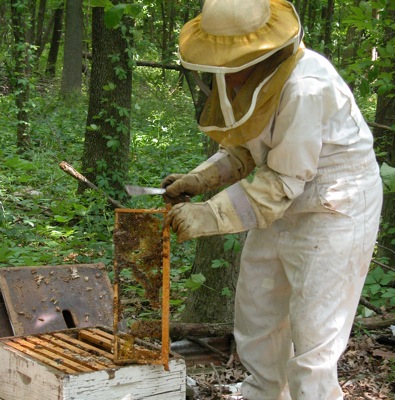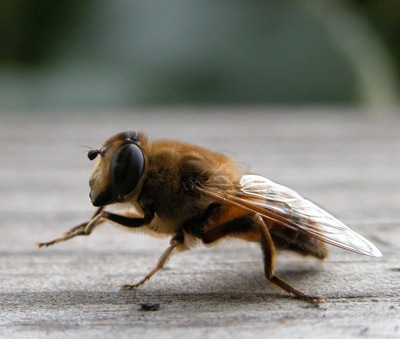Tuesday, June 5th, 2007
Missing bees could sting economy
By Shelley Grieshop

Photo by Shelley Grieshop/The Daily Standard
Cindy Piper of Celina uses a smoke canister to ward off angry honeybees as she lifts the outer cover to check on an active colony.
Beekeeping isn't a glamorous job and recent widespread colony losses have experts worried about its future and the impact on the world food supply.
This spring beekeepers across the nation discovered they'd lost an unusually high number of honeybees during the winter months - in some cases, whole colonies of more than 60,000 bees. Currently, there are no answers and not much anyone can do to prevent the situation from getting worse.
"We need to know exactly what's causing it first," said Tom Piper of Celina, a bee inspector for Mercer and Auglaize counties. "We're hoping it's behind us now."
Piper noted that most of the 3,500 beekeepers statewide lost an average of 70 percent of their established colonies. Across the United States, the apiculture industry lost one-fourth of its colonies - five times the normal loss.
Without pollination from bees, many foods would never make it to the dinner table. Local crops relying on pollination include apples, blueberries, melons, cherries, strawberries, broccoli, cauliflower, carrots, onions, sunflowers, cabbage, horseradish, rhubarb, sweet potatoes and more.
Bee pollination affects half of America's diet with a monetary value of $15 billion annually, scientists say. Bees are so important that Congress has recently held hearings on the issue and bee associations across the country are raising funds to research the problem.
Colony Collapse Disorder (CCD) has been widely publicized as a possible cause - or scapegoat, some say - for the bee crisis. Many beekeepers are a little skeptical of that notion and say CCD might be nothing more than a "catch-all" for a phenomena no one has answers for, says Tim Arheit, vice president of Northwest Ohio Beekeepers Association.
"It's a big unknown, we're looking at a lot of issues right now. Overall, I think it's more than one thing going on," said Arheit, who lost about half of his 100 colonies during the winter.
CCD has unique symptoms such as the "bees are here today and gone tomorrow" syndrome. That doesn't appear to be the case in a lot of apiary operations inspected this spring in Ohio.
Ohio's weather, starting last summer through this spring, played a big part in colony losses, some bee experts say. Unusually wet weather last summer contributed to less nectar production and fewer days for bees to forage, which all spells less honey for bee and human consumption.
When temperatures became unseasonably warm in January, bees thought it was spring, laid eggs and left the hives. Bad move.
"When it got cold again, they couldn't keep themselves and their eggs warm. To do so, they couldn't leave the eggs to get honey. Many starved to death," explained Don Steinke of Steinke's Bee World in Wapakoneta.
Even bees lucky enough to access honey, may not have had enough. A typical hive needs about 60-80 pounds of honey to survive a winter.
Steinke had 180 hives at the end of fall last year but only 35 active ones when he took count this spring. Like other beekeepers, he'll need to buy queen bees and swarms this year to keep his operation going.
Steinke sells his honey and bees wax for profit and sometimes leases his bees for pollination at a rate of about $40 per hive. He's been raising bees for 43 years, but said it's gotten a lot harder during the last 20 years. He blames it on something more than the weather.
"We're importing diseases. This country here lets everything in," he said.
Diseases, mites and heavy pesticide usage are contributing factors to the overall problem, beekeepers have said.
The Department of Agriculture recently asked farmers to increase their diversity of crops to help encourage the bee population in particular areas. They also would like to see property owners create more woodlots and waterways and plant flowering trees and ditches to help attract the buzzing insects.
"We're asking farmers not to spray when soybeans are blooming to help preserve the bees that are out there," said John Smith, agriculture/natural resources agent for the Ohio State University Extension office in Auglaize County.
It might be difficult to get full compliance this summer because farmers can anticipate a larger invasion of soybean aphids, he added.
Arheit, who breeds bees, said there may be a silver lining to the recent colony losses. The bizarre occurrence may have helped weed out the weak. So far this year, honey production appears to be on its way back to normal ranges, he said.
"It's just another bump in the road," he said, adding only time will tell if the problem is here to stay.
Arheit said he hopes the recent woes of beekeepers won't discourage anyone from joining the ranks.
"It's really quite fascinating if you can get past that first sting," he said.

Photo by Shelley Grieshop/The Daily Standard
Cindy Piper examines an inactive hive and the empty super that would normally contain stored surplus honey. Her husband, Tom, is a bee inspector with the Department of Agriculture for Auglaize and Mercer counties.

Photo by Shelley Grieshop/The Daily Standard
A honeybee pauses for a brief stay on an area porch railing before buzzing off to a basket of nearby flowers. The bee population in Ohio and nationwide plummeted during the winter and experts are still puzzled by the phenomena. The effect of fewer bees to pollinate crops of all types could spell problems for the U.S. food supply.




